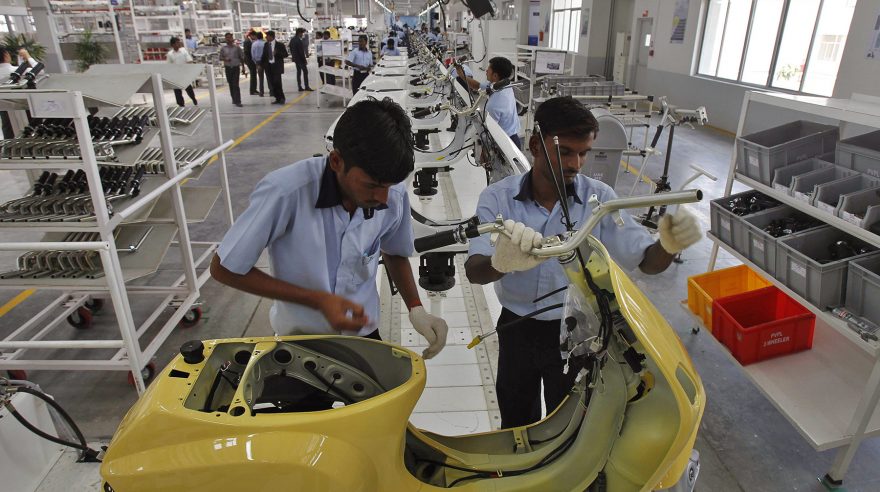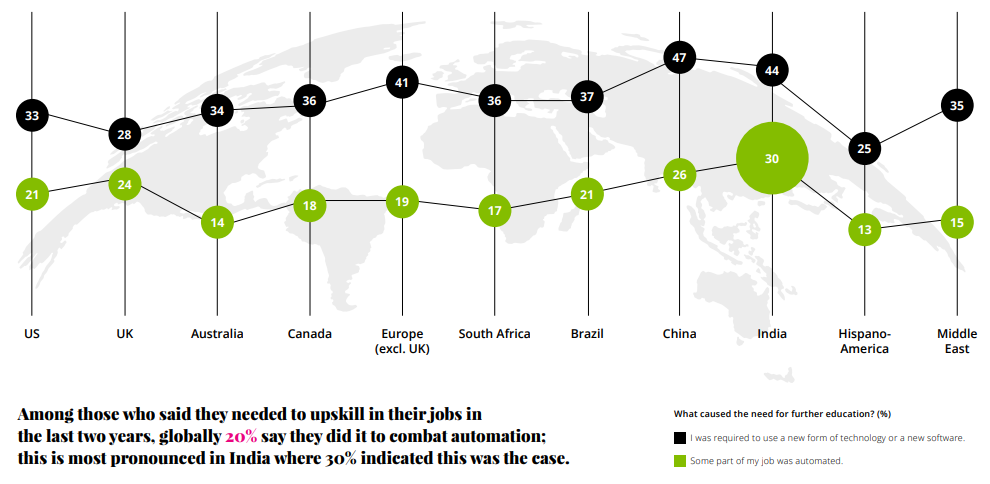Automation Fueling Hunger for Education, Pearson Study Finds

The specter of automation, and the possibility of losing a job or not being able to keep up with the needs of the market, hangs over workers in many professions. Not just in the United States, but in fast-changing markets like China and India, too.
A new survey conducted by the Harris Poll on behalf of Pearson, found that 20 percent of workers across 19 countries say they’ve had to “upskill” on their jobs through education over the past two years because some part of their work duties have been automated. Twenty-one percent of workers in the U.S. said they have taken that step. The need is even higher in fast-developing nations, such as China, where 26 percent said they’ve pursued further education because some part of their job was automated, and India, where 31 percent of those surveyed said they’ve done so — the highest portion for any country in the survey.
An even greater portion of workers, 37 percent, say they’ve already been required to get further education because they were required to use a new form of technology or software. Thirty-three percent of the U.S. adults surveyed said they’ve pursued education for that reason. The percentages were even higher in China (47 percent) and India (44 percent).
Automation, and rising demands for tech and software skills were bigger motivators in workers pursuing more education than other factors, such as receiving a promotion on the job, said Asha Choksi, Pearson’s vice president of global research and insights, who led the study.
As much as automation has the potential to disrupt the U.S. workforce, it’s an even bigger concern in countries such as China and India, because of the breakneck changes in the job market, Choksi added. She pointed to the growth of businesses in India that are using new forms of technology, such as artificial intelligence, and the large number of entrepreneurs bringing new businesses into the market.
“Across the board, people in China and India have demonstrated that they’re upskilling on a large scale,” Choksi said in an interview. “The economic pace of change in those countries clearly has something to do with it.”

The online survey was conducted by the Harris Poll of 11,083 individuals, ages 16-70, across 19 nations. The margin of error for any particular country figure cited in the report was 3 percent.
The results were weighted for age, gender, region, urban residency, race/ethnicity, education, marital status, household income, and/or socio-economic status to align respondents with actual proportions in their countries.
Other insights from the survey on how workers are responding to changing demands on the job:
- High percentages of those surveyed said that both STEM skills and “uniquely human skills like creative thinking, reasoning and collaboration,” will be needed in the future job market. For instance, 89 percent of survey respondents in the U.S. said “uniquely human” skills will be needed, and 85 percent pointed to STEM skills. In China, 94 percent cited a need for uniquely human skills, and 87 percent agreed that STEM will be needed.
- 27 percent of respondents from the U.S. said coding will be the most important job skill in the future. (Other choices included Chinese and Spanish language ability.) Among Chinese and Indian respondents, 33 percent and 18 percent, respectively, pointed to coding.
- 54 percent of U.S. respondents said that they believe their education system is doing a good job of keeping up with workforce demands. In China, 67 percent of those surveyed had that belief. Sixty-four percent of Indian citizens, and 62 percent of respondents from Middle Eastern nations, respectively, had that view.
- The survey found mixed opinions across nations, when respondents with postsecondary degrees were asked if going to college was the right choice. Sixty-one percent of U.S. respondents said it was; 30 percent said they’d pursue vocational training instead of postsecondary education; and 9 percent said they’d go straight to work after high school or secondary education. But in India, just 47 percent said they’d still go to college, and 39 percent said they would choose vocational study. Thirteen percent said they’d go straight to work.
The interest in going straight to work or pursuing career-focused training in India and other developing nations is in one sense not surprising, said Choksi. Workers in those countries may see the job market changing so quickly that they don’t believe they can afford to set aside a few years of their lives for postsecondary training.
“There’s almost a rush for people to get on with their lives and learn what they need to do in the workforce” by jumping into it, Choksi said.
“It’s not that they don’t believe learning is important…They’re just not necessarily wedded to a four-year education.”
Follow EdWeek Market Brief on Twitter @EdMarketBrief or connect with us on LinkedIn.
Photo: Indian workers at the manufacturing unit of a Vespa scooters plant in Baramati. –Rafiq Maqbool/AP
See also:

Thank you for your share! Your shared information is very helpful to me and many people are looking for them just like me! The problem may seem simple, but through your pen, it impresses me!
Great Stuff!
nice post
thanks
malaria skin rash https://chloroquineorigin.com/# hydroxychloroquine